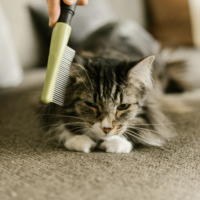Pets are our children. We walk them, cuddle them, and teach them. We share our beds with them, our snacks, our shampoo… our shampoo? Wait a minute. Should we do that?
Personal care products, like shampoo, are personal for a reason. Should we assume that what we use every day to wash our hair, brush our teeth, or moisturize our skin can be shared with our dogs and cats? NO!
Make no assumptions!
Here are some common items sitting in our cabinets that we tend to share with our furry friends. Some are safe, while others may cause trouble. Instead of assuming, let’s get informed.
- Shampoo. Dogs and even fastidious felines need occasional bathing. It’s easy to grab our human shampoo and lather up Fido, but both dogs and cats should use shampoo formulated specifically for pets. Here’s why… Dogs, cats, and people have a thin layer on their skin called the acid mantle which protects the stratum corneum (outermost skin layer). The acid mantle discourages contamination by viruses and bacteria, as well as maintains hydration by increasing water absorption and decreasing evaporation. The acid mantle is washed away with bathing, so shampoos and soaps often contain moisturizers that protect the skin until the acid mantle is renewed. To do this, the shampoo must maintain the skin’s normal pH level. The pH of a human scalp is acidic (5.2 to 6.2), while the coat of dogs and cats is more neutral pH (6.2-7.5). Bathing your pet with human shampoo disrupts the acid mantle and thwarts the renewal of this protective barrier setting our pets up for skin issues. Moreover, we have 10-15 layers of skin cells, but our pets only have 3-5, so they really need a healthy skin barrier. Some human shampoos are gentle and can be used on pets occasionally. In a pinch, grab the baby shampoo.
- Hair conditioner. Conditioners applied after shampooing do the same thing for our pets as they do for us: seal the hair shafts and reduce moisture loss. Plus, they make comb outs much easier, especially for long-haired cats and dogs. Like shampoos, conditioners have to maintain a pH level appropriate for our pets. Human conditioners may be too acidic which can cause skin irritation and itching. They may also contain excess oils that aren’t healthy for your pet’s coat.
- Body lotion. Yes, dogs and cats do get dry skin. Yes, flaky skin needs to be addressed. No, you shouldn’t slather Fluffy with your favorite moisturizer. Pets tend to lick off whatever is applied to their coat and some human skin lotions contain chemicals that shouldn’t be swallowed. Ingestion of moisturizers may cause drooling, vomiting, and diarrhea in pets. Plus, dry skin may be one sign of an underlying medical condition like external parasites (think fleas or mange mites), thyroid disease, or allergies (including contact, inhalant, or food allergies). Specific skin issues require specific treatments, so it’s best to see your veterinarian before applying your body lotion to your pet.
- Antibiotic ointment. Here’s one personal care product that can be shared with your pet. Many people keep antibiotic ointment on hand in case they get a minor cut or scrape. It’s good to use on our pets for the same type of injuries. But here’s the key: Watch your pet for 10-15 minutes after application to allow time for the medication to be absorbed. While not likely toxic, triple antibiotic ointment contains oils that may cause vomiting or diarrhea when consumed. Plus, it won’t work if your pet licks it off!
- Steroid ointment. People use short-acting hydrocortisone creams to treat itching and may be tempted to apply this product to bug bites or itchy areas on their pet’s skin. The over-the-counter varieties usually don’t contain high levels of steroids, but if your pet ingests them and has a sensitivity to steroids, they may exhibit gastrointestinal (GI) symptoms, panting, or increased thirst and urination. It’s best to consult your veterinarian before applying steroid creams and monitor your pet so they don’t lick them off.
- Calamine lotion. Here’s another soothing application for itchy skin. You may grab the liquid pink stuff when you have poison ivy or bug bites, but don’t use it on your pet. Calamine products usually contain zinc oxide that can cause uncomfortable GI issues in dogs and cats. Ingestion of zinc oxide can also affect red blood cells and cause anemia.
- Sunscreen. Did you know that sun exposure can cause sunburns and skin cancer in our pets? The nose and tips of the ears are particularly vulnerable to sunburn. We may be tempted to apply our sunscreen to our pets, but beware! Human sunscreen often contains zinc oxide which can damage your pet’s red blood cells and cause intestinal upset if ingested, and human sunscreens may also contain low amounts of octisalate, a salicylate that is particularly harmful to cats. There are many pet-friendly sunscreens on the market, so we don’t need to share ours.
- Toothpaste. Whew! Sometimes our pet’s breath will take our breath away! Brushing your pet’s teeth will help prevent bad breath and periodontal disease. So, let’s brush! But let’s not use our toothpaste! Human toothpaste is foamy due to a chemical called sodium lauryl sulfate (SLS). Humans brush their teeth and spit out the suds. Dogs and cats don’t spit. They swallow. If SLS is swallowed it can cause intestinal upset. Pet toothpaste doesn’t foam and is meant to be swallowed. Besides, pet toothpaste is appropriately flavored. What dog or cat wouldn’t choose beef or chicken flavoring over minty freshness? Human toothpaste also may contain fluoride which can be harmful to pets. Dogs and cats probably won’t consume a huge amount of human toothpaste at one sitting, so acute fluoride toxicity is unlikely. But consuming a tiny amount of fluoride over months or years may build up to a toxic level. Symptoms of acute versus chronic fluoride toxicity are different, but may include drooling, vomiting, weakness, incontinence, seizures, and tooth discoloration. Human toothpaste may also contain xylitol, a sugar-free sweetener that has been associated with prevention of tooth decay. Unfortunately, xylitol is very dangerous for pets, causing liver damage and death. So this is another personal care product not to be shared.
- Anti-fungal cream. Some dogs lick their paws resulting in smelly, discolored areas, particularly between the paws. Not all smelly feet are treated alike, so avoid applying our antifungal cream to Fido’s tootsies. Although it’s not usually toxic, swallowing these ointments may cause GI upset. Dogs do get foot fungus, but it’s best to consult your veterinarian regarding treatment.
- Muscle rubs. After a long run, we can have sore muscles. It may help to apply an over-the-counter compound, but we should not rub down Fluffy with it. Many muscle rubs contain salicylates that can cause vomiting and diarrhea if ingested. Other muscle soothing agents contain menthol and capsaicin which can further irritate the GI tract. Dogs tend to lick sore legs and will likely ingest the muscle rubs. Vomiting and diarrhea are no fun!
We care for our pets, we share lots of things with them, but our personal care products should be safeguarded solely for our use.
© Copyright 2019 LifeLearn Inc. Used and/or modified with permission under license.






